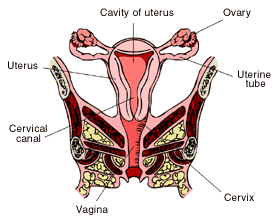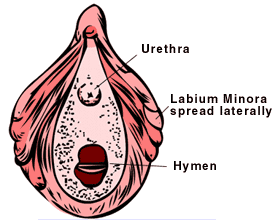Many couples are unable to have intercourse because the woman finds that it hurts too much. One woman, named Victoria, described her situation like this:
"When we used to try to have my partner's penis enter, it wouldn't go in - it felt too tight - there was a painful, burning sensation.
Now we don't try anymore. We used to be sexual in other ways - arouse each other, and we both would have orgasms. Now I really don't want to do that either because it reminds me of what I can't do, which is have intercourse.
I've been to physicians, but they were suggesting an examination, and I can't tolerate a speculum being inserted. But I still want to get help."

Figure 1
Vaginal area muscles as the origin of intercourse pain.
What causes this pain?
Pain from intercourse can start from one or several possible origins.
- Sometimes the underlying problem is due to the tightness of the muscles that make up the vagina itself (see Figure 1). The vagina is a collapsed hollow tube made of muscle. Often, muscle tightening of the vagina itself is combined with extra tightness of the muscles around the vaginal opening, both just under the level of the lips or labia, and also deeper around the base of the bladder. These surrounding muscles are the ones women can tighten when trying not to pass urine or gas. The name for the over-tightness of these muscles is vaginismus.
- When muscle tightness has been present for a long time, over many years, sore spots can develop around the edge of the opening of the vagina, just where the hymen attaches to the internal lips or labia (see Figure 2). The area between the internal lips is called the vestibule, and when these sites are sore. This condition is called vestibulitis.

Figure 2
Sites of hypersensitivity and soreness in vestibulitis.
- More severe vestibulitis feels like a burning discomfort on a day-to-day basis, usually much worse around a woman's menstrual cycle. This burning of the vulva is called vulvodynia. Vestibulitis also results in a burning sensation from the partner's semen when he ejaculates inside her vagina. Also, she may sense burning when she urinates after intercourse.
- Very rarely, a woman is born with or develops, a tissue structure that makes an entrance by the penis impossible.
- For instance, the hymen may be made of tissue that doesn't stretch.
- Women who can have intercourse, but with pain, may well have problems with the vagina itself, not just the opening, or even with more internal structures. Infection or lack of estrogen might be involved, and it's important to have this checked by a physician.
- Another common reason is simply that the woman is not aroused when intercourse is occurring and the vagina is not sufficiently enlarged or lubricated. This causes the movement of the penis to become more and more uncomfortable.
- Deeper pains felt in the abdomen with deep thrusting should be checked out by the family doctor or gynecologist.
Can anything be done about the pain?
Although women are not able to voluntarily change the tightness of the muscle fibers that make up the vagina itself, these muscles can be "reprogrammed."
You can place small inserts in the vagina, like a tampon, and leave them for 10 to 15 minutes while you read a book. The vaginal muscle does not react to this small amount of pressure.
Over a few weeks, you can increase the size of the insert, and the muscles become gradually reprogrammed not to automatically contract. Correcting the underlying muscle tone often helps these sites become less sensitive and sore.
It's also helpful to avoid irritants like soap, bubble baths, and the heat created by wearing synthetic underwear or plastic-lined menstrual pads.
Locally applied creams containing anti-inflammatory medications can also help.
Fortunately, even if you have always experienced pain and have a lot of fear, things can change. Women in this situation have usually avoided using tampons and do not allow either their own finger or their partner's finger to touch the opening of the vagina when they're sexual. So, the only messages your brain has received from that area are those of pain when you tried to have intercourse.
A woman can, however, over a number of weeks, build up a different memory in her mind associated with touch to the area around the vagina.
You can begin by touching as close as you can to the vaginal opening. Maybe you'll need to start in the groin and gradually work inwards till you can put a finger on - but not in the opening of the vagina, just to create a neutral sensation to which you neither reacts nor contracts the muscles around the vagina. Once you’re used to neutral touch by your own hand, at home practicing in private every day, you can then begin to touch with the insert and ultimately, gently put the insert into the vagina itself.
Once you're able to touch the opening of the vagina yourself, it's important to have a very careful inspection by a family physician or gynecologist.
During the exam, it is helpful for you to be able to sit upon the examining couch, using a mirror and light so that you are in control of what is going on, and are able to see where the physician is looking. Any touching that needs to be done, you could do. Again, this will increase your feeling of control and your ability to tell whether touch causes soreness and pain.
Checking the lower part of the vagina may be easily accomplished with your finger under the doctor's guidance. Or you could take the doctor's gloved finger and place it in your vagina under your own control so that both you and your doctor can be reassured that there is no anatomical defect.
Rosemary Basson, MD
in association with the MediResource Clinical Team



No comments: